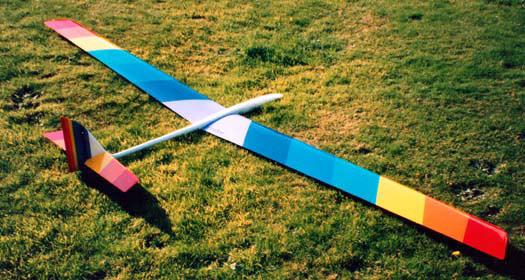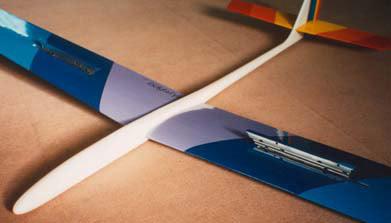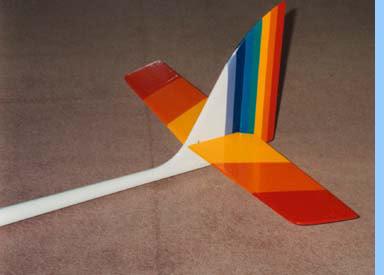|
Algebra 3m Mk II Kit Review by Trevor Hewson (Originally written in 1994 for 'Sloping Off', the Newsletter of the Christchurch and District Model Flying Club) Decisions When it comes to flat field soaring though, I have for many years relied solely on the faithful Osprey 100 and so the idea of the Algebra was to have something to cope with windier flat field conditions which would also serve as an alternative to a pure floater in light conditions at the slope. As with many 'cottage industry' produced kits, the Algebra is packed in a plain brown cardboard box. This one though shows clearly the many years experience that Dick Edmunds has had in supplying kits mail order. Not only is the box itself very sturdy, but bits of foam block are fixed inside and lots of Sellotape is used in order to make sure that nothing can move around in transit. This has a downside when buying over the counter at Sandown - it is just not practicable to remove the components to examine them. Talking to Dick did though help me to finalise my decision on which model to go for and the fact that he only had white fuselages left went a long way to convincing me that I didn't really want a red one! The only other decision needed was the wing section. Here I opted for the SD 7037, for no other reason than that it is the newer one and he wouldn't have gone to the trouble introducing it if it wasn't better, would he? Inspection There are quite a lot of wooden parts and a parts list would have been helpful to check that they were all there. However, they are all numbered and so identification is no problem. The instructions are best described as adequate, but bitty and confusing would be equally fair. Everything you need to know is there - somewhere! The fragmented nature of the instructions and diagrams was compounded in my case by my having a separate sheet showing how to build the model with ailerons, the kit being basically a rudder/elevator version. I noticed recently that the MkIII Algebra is now available, in either aileron or R/E form, so maybe a new set of integrated instructions has been produced. More Decisions
Whilst the components are of a reasonably high standard, for such a long established kit, there are a few surprising errors. The wing root ribs are too short, the hardwood leading edges not quite deep enough, and the wing joining blocks also just slightly less deep than the wing. Whether these are manufacturing errors or whether they are a result of the change to the SD 7037 wing section, I don't know. They are easily coped with, but irritating nonetheless. The Fus The moment when all these linkage and assembly problems are solved and control surfaces move for the first time is for me always the highlight of the building process. As is often the case when space is tight, the final installation looks quite neat, but with a closed loop to the rudder, a wooden pushrod to the all moving tail, the airbrake bellcrank assembly, two servo leads joining onto extension leads, two joiner rods and a spring to hold the wings together, I have to admit it is a bit of a fiddle to rig. Colour Coding?
Provided a model is built reasonably true, the only real sources of anxiety on maiden flights should be the cg and the pitch trim. The cg was set at the forward limit of the recommended range, but with an all moving tail there is always an element of doubt about the trim. Those of you who know this slope will be familiar with the fight through the turbulence to get out past the trees. Once out there, I eased off the stick and discovered that full down trim was just enough to stop the model from stalling but not sufficient for it to fly forwards! Nevertheless, the flight was enjoyable and I was able to establish that the stall was innocuous (no doubt due to the forward cg position), loops were smooth and rolls take an awful lot of sky - still, this is supposed to be a thermal soarer! Next on the test schedule were the brakes. These are double bladed Graupner brakes and proved very effective but produced a marked pitch down effect. Given my shortage of down trim and the blustery conditions this was not altogether a bad thing and after a couple of dummy runs, the Algebra came in for a fast, but flat and safe landing, the right hand wing neatly slicing the top off a very wet cow pat on the way! At that point I decided enough was enough, and went home to fit a towhook, adjust the elevator trim and mix in some 'up' with the airbrakes. A second outing in lighter conditions at the South East slope was a little more infomative. With the right amount of elevator mixed with the airbrakes, a little more aileron movement and the cg eased back towards the centre of the recommended range, the model felt quite at home thermal hunting off the slope. So far, so good. Conclusion |
||


